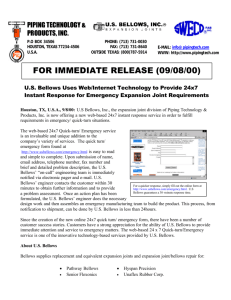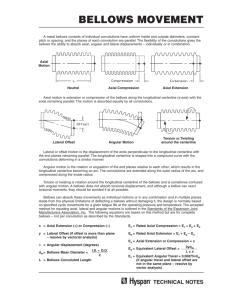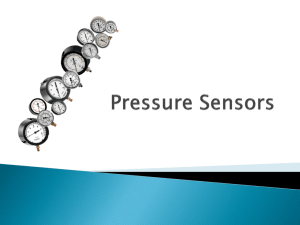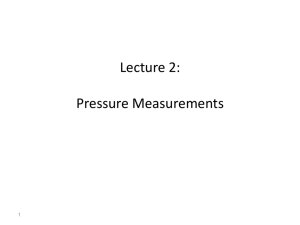Aluminum bellows for experiments - Indico
advertisement
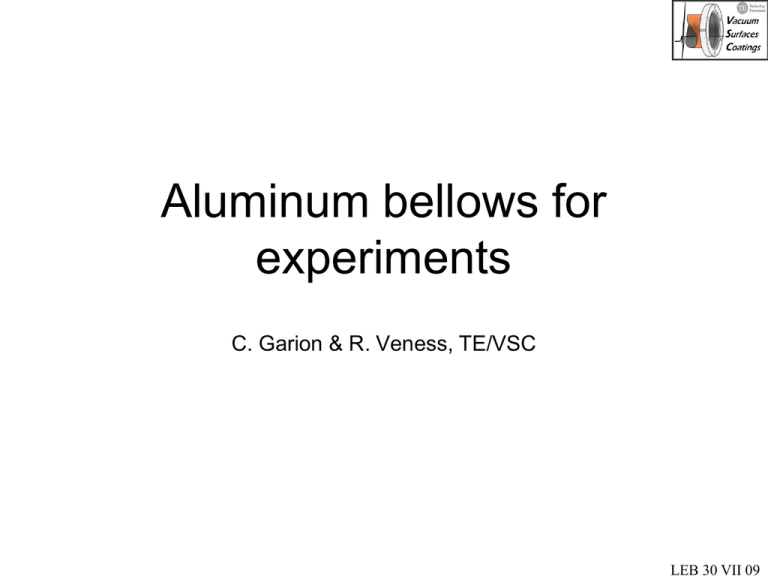
Aluminum bellows for experiments C. Garion & R. Veness, TE/VSC C. Garion LEB 30 VII 09 Outline • Development history • 2 ways of procurement Japanese company CERN • Development at CERN Material Bellows parameters Bellows manufacturing Present situation and further actions • Conlusions C. Garion LEB 30 VII 09 Development History • Formed Bellows – European industry R&D project (1999-2001) • Thick-walled aluminium bellows are made for cryogenic applications, but no standard production of thin-walled bellows in Europe • 2 development projects were followed with European manufacturers, but neither successful results nor much interest • Machined Bellows – CERN Workshops (2001-2006) • Good results obtained for 0.3 mm thick bellows • Pieces installed in LHCb (small stroke) • Leaks during production and test linked to material form and quality R.Veness C. Garion LEB 30 VII 09 LEB 30 VII 09 Japanese Industry • Background – Both Titanium and Aluminium bellows have been used in accelerator vacuum systems in Japan (TRISTAN and J-PARC) – They were produced by Japanese industry in large numbers following joint development projects with the labs – With help from KEK, a potential supplier was identified, and CERN issued a specification R.Veness C. Garion LEB 30 VII 09 Development Contract • Prototype series – Order placed in June ‘09 for a series of 3 bellows, as per the drawing opposite – Delivery expected end Oct ’09 • Full series – An offer has been made for a series of 30 bellows – Unit Price ~ 1800 CHF/piece – 3 months delivery R.Veness C. Garion LEB 30 VII 09 CERN development for formed bellows Material Requirements: Formability (high ductility) Weldability (also with 2219) Low Heat affected zone Available in thin foils Good mechanical properties 2 materials: series 5000 (Magnesium): Well weldable Good corrosion resistance Mechanical properties acceptable Non heat treatable 5754 H22: 0.3mm thick 5083 H111, 0.2 and 0.3mm thick (available beginning of September) 0.2 and 0.3 mm thick C. Garion LEB 30 VII 09 Design Algorithm of optimization of bellows expansion joints (Based on EJMA) •Minimise the objective function: Fax ( x bl ) Cf •inequality constraints: bellows convoluted length inner diameter outer diameter bellows maxi compression 3 t p n p E T d m w n c Lmax Lbl 0 Din Dmin 0 Dmax Dout 0 bl min 0 Atlas constraints (technical specification EDMS 429891): Lbmax = 100 mm Dmin ~ 60 mm Dmax = 80 mm Stroke = -24/+8mm membrane stress membrane stress membrane & bending stress Sad S1 0 Sad S2 0 S34 (S3 S4 ) 0 fatigue life Nf (St ) Nf 0 0 column buckling in-plane squirm Pcol P1 0 Pinp P2 0 C. Garion Nf > 500 cycles LEB 30 VII 09 Design Bellows parameters Thickness 0.2 mm Thickness 0.3 mm 100 100 Stiffness 20 3 7 10 11 Number of convolutions Bellows length 0 15 90 19 60 15 80 Number of convolutions 30 70 11 40 55 7 50 40 3 40 90 80 70 60 50 Stiffness 40 30 20 10 0 Bellows length Design has to be compatible with formability capacity Other wish: if possible use the same tooling: 0.3mm thick: 13 convolutions, bellows length: ~96mm, Inner diameter: 60 mm, outer diameter: 78.8mm 0.2mm thick: 8 convolutions, bellows length: ~59mm, Inner diameter: 60 mm, outer diameter: 78.8mm C. Garion LEB 30 VII 09 Bellows manufacturing (courtesy of L. Prever Loiri, EN/MME) Aluminum foil Rolled tube & longitudinal weld (EB) Welds of the end fittings (EB) Cut of the end fittings Forming @150°C combining pressure and displacement loading C. Garion LEB 30 VII 09 Present situation 2 materials have been chosen: •5754 has been received, metallurgical and mechanical tests have been done (EN/MME) •5083 has been ordered. Delivery is expected beginning of September Metallurgical observations (grain size, inclusions) Tensile test at room temperature Bellows parameters have been defined and optimized Welding procedure has been determined C. Garion Micrograph of longitudinal weld LEB 30 VII 09 Present situation Tooling (forming and welding) have been designed and manufactured (EN/MME) Tubes are equipped with the end fittings First tube equipped with the end fittings is ready for forming Analysis is being done to optimize the forming process (pressure-displacement function) C. Garion LEB 30 VII 09 Forming simulation Mesh Mesh Deformed shapes Pressure Displacement Plastic strain after forming Further detailed FE analysis willC.be done (A. Sarrio Martinez) Garion LEB 30 VII 09 Next steps Forming tests on 5754 tube: -As assembled -After heat treatment (annealing)? Qualification tests: -Leak tightness -Fatigue life a room temperature -Stability? Reception of 5083 and metallurgical tests Welding tests Forming Qualification: -Leak tightness -Fatigue life a room temperature -Stability? C. Garion LEB 30 VII 09 Tentative schedule (Alba Sarrio) First bellows by August 2009 C. Garion End of prototyping: 12/09 Series LEB 30 VII 09 Conclusions An order has been placed to a Japanese company for aluminum bellows prototypes Development of aluminum bellows at CERN is well advanced: -2 Material chosen: 1 delivered and 1 available beginning of September -Forming process at “high” temperature will be used -Bellows parameters are defined -Welding process are defined -Tooling for forming are ready Forming process will probably not be straight forward. Iterations might be necessary. C. Garion LEB 30 VII 09
